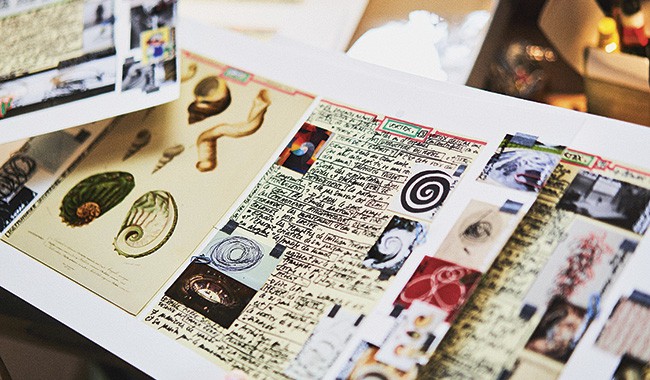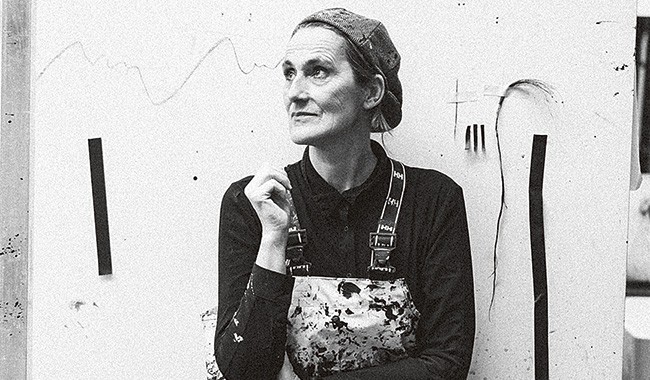Trained in calligraphy in China with a master in the early 1980s, this internationally renowned artist works in the solitude of her studio located in Vexin. Equipped with huge horsehair brushes made by her, using a technique dating back to the Tang (618-907), Fabienne Verdier works standing, on the floor on canvases of several square meters, involving her body and his mind. An austere life, made of rituals, attentive to the circulation of vital energies, and whose brush movements are unique, definitive, and the fruit of long meditation.
The year 2016 marked a turning point in the artistic career of this ascetic, who, with the master glassmaker Flavie Serrière Vincent-Petit, created her first stained glass windows for the church of Nogent-sur-Seine. Fascinated by the mystery of light, the artist had to come into contact with new materials for the first time and confront other methods and know-how.
In 2016, you made your first stained glass windows for the church in Nogent-sur-Seine with master glassmaker Flavie Serrière Vincent-Petit. What attracted you to this project?
I am fascinated by the mystery of light. I told myself that by focusing on the art of stained glass and in particular iridescence (the vibration of color thanks to the reflection of light), I would learn something… while ignoring that it would cause such a rethinking. question !

What meaning does stained glass have in your eyes, you who are a painter of movement?
Stained glass is an art of great spirituality, elusive, because the light changes every second. It confronts us with the great mystery of the refraction of the spectrum of white light in space, contrary to the opaque fixity of color on the canvas. To work in stained glass is to revolve around this mystery. There is that extra je-ne-sais-quoi that sanctifies the gesture of painting and gives it another dimension; an immateriality that is not easy to touch.
Nicolas de Staël said that, in painting, we were facing a wall and that it was very difficult to pierce it to reach other dimensions. With stained glass, we leave the wooden frame, the canvas, and suddenly the form has its own life, autonomous, and its dynamic lives in clothes of light in space according to the course of the sun and makes the public live. this cosmic dance. It’s wonderful, very moving and it goes beyond the painter: suddenly, part of the vitality of the painting lives in the 3D space.
The history of Champagne stained glass dates back to the 16th century. How did you combine traditional know-how and contemporary aesthetics?
We used the emblematic technique of silver yellow (the color of oven-baked gold) and grisaille. I had the dream of bringing this yellow to life, no longer imagining figurative and biblical scenes but abstract forms, whose breath and vital, spiritual energy would cross the bays of this golden light. The challenge was therefore that this silver yellow could stand on its own and not be absorbed by the glasses.
We have implemented a new technique that has allowed us not to outline it, as was traditionally done, with grisaille drawings or lead shots. Two years of work and research in our respective workshops were necessary. While we constantly doubted whether to find this new alchemy, one evening we made a new mixture and the next day, when it came out of the oven, a new writing of fire and gold appeared, embodied on the glass…
What did you want to represent with these shapes on the stained glass windows of the Saint-Laurent church?
This great universal energy, be it light, the movements of the river, water, air, dreams, which passes from bay to bay in the church, which transports and conveys life. Initially, the priest warned us that this would be difficult to accept for some, attached to their icons and biblical scenes. So I tried to bring them to another form in space by explaining to them that this could free them from figuration, to gain freedom in the perception of the mystery of the living, of the breath of the Spirit.
Did you perceive a difference in the act of creation, since your work was going to be registered in a church?
He was imbued with a heightened awareness and a desire to grasp something more. The act of creation was also more serious, because I could not allow myself to disappoint the people of Nogent. Moreover, having my work integrated into a place of worship seemed to me like an exchange of humanity: trying, together, to continue to marvel at this light that brings us life on earth. This is something extraordinary that must be made sacred.
After this first experience, you worked on the oculus of the chapel of the old Hôtel-Dieu, at the city of stained glass in Troyes…
… And I was able to renew the experience of the silver yellow on this oculus, the city’s beacon in the evening, and a luminous marker between 2 p.m. and 5:30 p.m. Yourselves when you are in the chapel, you can turn around, and it takes on multiple forms depending on where you are. It is in perpetual motion and therefore alive. I thus created a stained glass window in the shape of a vortex in this oculus, a whirlwind shape on which I have been working for a few years. My wish is thus to help people to perceive this circulation between the chapel and the celestial.
Then, in 2021, the Camille-Claudel museum asked me to create two stained glass windows, entitled Vortex forces. Tribute to Camille Claudel’s Waltz, representing a couple entwined, swirling in the intoxication of the dance. With Flavie Serrière Vincent-Petit we were thus able to create a relationship between the museum, the church of Nogent-sur-Seine, and the City of stained glass in Troyes.
You who work in solitude, how did you experience this collaboration?
It took an effort from me to leave my studio to go and listen to another place, to question all my technique, to take permanent risks, and to know that, perhaps, all this time would lead to failure. But, ultimately, I loved this collaboration. After 40 years of work, rigorous asceticism, psychic, moral, nervous fatigue, confrontation with the life of matter, the fact of feeling in another workshop the same desires, wonders, exhaustions and constraints touched me a lot. We were able to discuss our experiences, our processes, our acts of creation… and learned a lot from each other.
What did you learn ?
This required a work of humility and tenacity from me; from one end to the other we were not sure of succeeding. Living such an experience was very impressive for me: everything no longer depends on the painter because he himself is dependent on an entire workshop. I put in my brush no longer acrylic paint with its fluidity, and all my knowledge, but this mixture of yellow and greyness resembling earth. When it moved over the glasses, my brush screeched and I worked blindly: I didn’t know what it was going to look like, in terms of emptiness, fullness, dynamics and vigor of the line.
Also, stained glass is a very delicate job. You have to make several for a work because you are never safe from having a glass that breaks in the oven or during handling. I flew above the vortices thanks to a sort of tracking shot to be able to paint the stained glass windows so as not to step on the glass! All the habits that I had been able to acquire were therefore turned upside down. And extraordinarily enriched.
Fabienne Verdier, alchemy of a stained glass window
Four years after the inauguration of the stained glass windows which occupy the three Gothic bays of the choir of the Saint-Laurent church in Nogent-sur-Seine, which has just been restored (and replaced the previous non-figurative stained glass windows created in 1957), this exhibition looks back on the backstage and techniques of this unique creation between Fabienne Verdier and master glassmaker Flavie Serrière Vincent-Petit. She also unveils a new work in homage to the waltz by Camille Claudel, Forces tourbillonnaires…, as well as a series of glass panels in grisaille and silver yellow entitled Topographies imaginaires. An unsuccessful version of the church’s stained glass windows is also temporarily installed in the former sculpture gallery of the Camille-Claudel museum.
Until September 26, 2022 at Camille Claudel Museum, in Nogent-sur-Seine (Aube).
Life really like.
To read
Catalog Fabienne Verdier, alchemy of a stained glass window, Snack, €20.
Fabienne Verdier: “Stained glass is an art of great spirituality”

